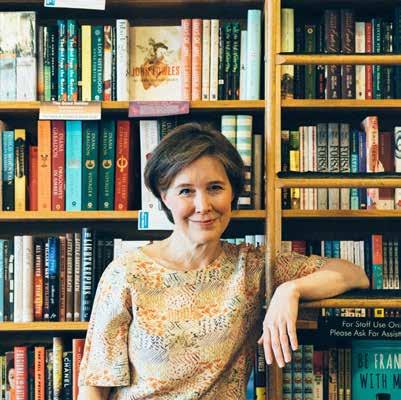3 minute read
Bunkering With Books
Decluttering and Downsizing BY CONNIE CRONLEY
I have bought so many books about decluttering and downsizing, my library is cluttered with them.
Marie Kondo’s “The Life-Changing Magic of Tidying Up” and “Spark Joy” advocate the most rigorous approach. These books from the Japanese author launched a decluttering movement, complete with a Netflix series. I like her concept: touch every item mindfully, and if it does not spark joy, eliminate it. However, I could not manage her process: pile everything (all clothes for example, or all books) in the middle of the room. Then, examine each item one by one. I know myself too well for that. One look at that pile and I would just move to another room and leave it behind, looming like the mysterious mountain in “Close Encounters of the Third Kind.”
The international best-seller “The Gentle Art of Swedish Death Cleaning” is not as gloomy as the title suggests. Author Margareta Magnusson, who says she is “somewhere between 80 and 100,” has done several final declutters for late relatives and even her own house. It isn’t sad, she says, it is invigorating. I like her suggestion of finding new homes for our special things by giving them as hostess gifts. I tried it, but I suspect I liked it more than the hostesses.
Peter Walsh’s “Let It Go” acknowledges upfront that downsizing can be stressful because it requires us to confront “our insecurities, our relationships and our own mortality.” He takes us step-by-step through serious decluttering with important lessons, such as: you are not your stuff; you’re entering a new identity phase, and you need to shed items sticky with negative emotions. Everything doesn’t have to go. Maybe hold on to a wedding dress that can be worn by someone later, or refashion it into a christening gown or wrap a wedding bouquet in a swathe of the fabric.

“Downsizing the Family Home” by nationally syndicated columnist Marni Jameson gets a great review from “The Wall Street Journal.” She cleared her own parents’ home, 50 years of treasures, respectfully but armed with “smelling salts and a bulldozer.” What to sell, donate or trash? She sought – and shares – advice from experts: antiques appraisers, garage-sale gurus, professional organizers and family psychologists. The process of learning, loving and letting go can be tremendously rewarding, she says, and creative. Her parents’ love letters? The family gathered on their wedding anniversary, burned them in a ritual and “sent the love back into the universe.”
Whew. Now that the heavy lifting is done, let’s read something for fun. I have just the thing.
“The Thursday Murder Club” by Richard Osman is one of the most charming books I’ve read in some time. Four friends in an affluent retirement village in Kent, all in their 70s and 80s, begin meeting regularly to discuss unsolved crimes. In their active careers, Joyce was a nurse; Ibrahim was a therapist; Ron was a fiery political activist, and – well, we’re not sure about Elizabeth, something vague and international. Soon they are using their professional skills, their experiences and their irrepressible enthusiasm to help the local constabulary solve a couple of local murders.
“Help” is not the word the police would choose, at least at first. “Meddle” would have been more appropriate. But the four turn out to be good at amateur sleuthing, having a wonderful time along the way. Many cups of tea are poured, but other beverages as well. Consulting one afternoon over cold beers beside the bowling green, Joyce says, “Well, isn’t this lovely. I never knew I liked beer. Imagine if I’d died at 70. I never would have known.”
I hope this becomes a series and I get to read more of the exploits of these British senior sleuths.









